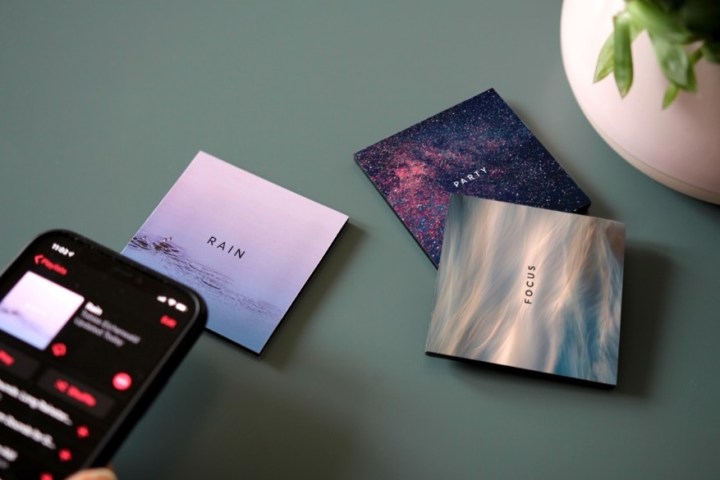
Senic — the company that has developed some new ways to interact with smart speakers and smart lights — now has a new way for you to interact with your favorite streaming services. Muse Blocks are 7cm by 7cm printed squares embedded with an NFC chip. That chip can be encoded to link to any song, album, playlist, or podcast from your favorite streaming music service, as long as the service supports linking. If your smartphone supports NFC, simply bringing it within 2cm of a Muse Block will automatically take you to the programmed location within your music service’s app.
The Blocks are made of acrylic glass and printed in a soft-touch matte laminate finish. They’re sold in three-packs for $15 — an introductory price that may go up — or you can buy them as a $79 seven-piece art set that comes attached to an ash wood bar that you can then wall-mount. The idea behind the Muse Blocks is to take what is essentially a digital-only medium and make it physical. At roughly a quarter the size of a CD case, each Block can only point to a single location on a music service, but you can easily reprogram anytime.
In fact, Blocks can be made to point to any online location that uses a static link. Senic says that it isn’t actively exploring such options, but users may find that many popular services like Netflix, If This Then That, and YouTube are compatible.

Not every phone supports NFC reading (or writing), however, and not all phones that support it will work with the automatic-launching feature. For instance, iPhones older than the iPhone 7 can’t read NFC chips at all. The iPhone 7, iPhone 8, and iPhone X series can read
You can choose to print your Muse Blocks using art from a collection that Senic has created specifically for the Blocks. These feature themes like “morning,” “yoga,” “focus,” and “relax.” There are several designs that don’t have a printed theme at all. But the big draw is the ability to custom-print your own Blocks. Senic lets you upload any square format JPG image, but there’s a catch: Much like with JBL’s new custom-printed speakers and headphones, you must own the rights to the image you upload.
That puts a dent in any plans folks might have to recreate their favorite albums using Muse Blocks, though Senic has not told us how carefully it will be policing users’ uploads for copyright violations.

Still, there should be plenty of room for creativity, and we think that enterprising music labels might start looking at ways to partner with Senic to offer non-reprogrammable Muse Blocks as promotional items tied to album launches.
You can order Muse Blocks right now, with delivery times running about two to three weeks for shipping to the U.S. and Canada from Germany, where the Blocks are made.
Editors' Recommendations
- Finnish fuel company will ruin your music if you drive too fast
- You won’t need 17 speakers to appreciate Dolby Atmos in Apple Music
- iHeartRadio turns your TV into a holiday-themed music photo frame
- Spotify finally lets you save more than 10,000 items to your music library
- How to move your Google Play library over to YouTube Music




